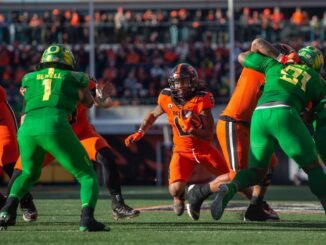
As we inch closer to the resumption of the college sports that we know and love, it’s important to think about how these college teams have attempted to survive through the drought in cash flow.
One such way is by implementing pay cuts to coaches like the Oregon Ducks have done. The assistant coaches at Oregon have taken a 10 % pay cut in their salaries, which totals about $308,000, and the head coaches’ 10 % cut totals about $1.1 million for a grand total of about $1.408 million saved on coaches’ salaries. There are also other employees who have been furloughed, and bonuses have also been halted.
Head coach Mario Cristobal said that one key reason the coaches accepted cuts so gracefully was because, “It’s something that now more than ever people have to show unity as we tackle this together, so no, it wasn’t difficult.”
Oregon isn’t alone, however. Numerous colleges across the country are also implementing these tactics in attempts to try and save some desperate cash. A few big-name schools include USC, Syracuse, and Virginia. Across the board, it seems that most colleges have the same idea — to shave off salaries to prevent a shortfall.
It may not be as evident, but one big thing to note is that with these pay cuts, UO has a lower chance to cut a college sport from the school entirely (unlike some other schools in the Power 5).
Plus, there are still various other expenses that will require cash, like athletic scholarships that will cost roughly $525,000 for the next season due to players returning in light of NCAA eligibility rules that pay cuts can help pay for.
But as of now, Cristobal and other coaches across the country are remaining optimistic that sports will come around later this fall. For Oregon, and a majority of athletic programs with football, it is vital that football can occur like normal because of the sheer size in revenue they generate for a school’s athletic department. At UO, college football accounts for 70% of the athletic department’s revenue.
Now, say what would happen if there was no football?
There would be severe consequences such as non-revenue generating college sports getting cut from schools (and with that high school student’s chances of getting scholarships to play) and people would; also be laid off. We need to remember that while we love to sit on our couch and watch sports, it is a business.
But, let’s be optimistic for a second. Say instead that football and other sports would be able to return. Well, then that’s a start. While the revenue from March through whenever a sports resume may be lost, it’s a start that can prevent even more severe results.
This is what most (football) departments are planning for. They understand that because of the virus, ticket sales will be down as stadiums have to limit the number of fans allowed to attend reducing a major source of revenue for college football programs like the Ducks.
Athletic departments aren’t entirely funded through their own programs. Instead, the NCAA helps out by distributing $800 million to hundreds of schools across the country. This also makes up a significant portion of some college funds, about 25% of total revenue in 2014 according to the Washington Post.
The Washington Post looked at the financial pages of 48 public schools in the Power 5 conferences in 2014 provided by the NCAA. They found that of the Pac-12 schools, only Oregon and Washington were actually profitable. It may be common knowledge by now that college programs are spending more than earning, but this issue is only amplified by the severe loss in revenue because of the coronavirus.
Imagine what would happen to UO without their football program, which generates a very sizable income for the athletic department. It wouldn’t be unreasonable to start to wonder how one of the two profitable programs in the Pac-12 is going to survive — much less anyone else in the division.
Taking this to a larger scale, let’s look at the NCAA and the impacts of no sports there on money for colleges. March Madness accounts for 75% of it’s over $1 billion revenue. Without this money, the NCAA can’t distribute funds like normal, causing lesser programs, ones who aren’t profitable, to face cash shortages to struggle far worse than the University of Oregon.
While a 10 % pay cut in a million-dollar salary may not seem much to you or me, it’s important to remember that these coaches direct programs that bring in millions of dollars. Regardless, if we want to see our favorite sports this fall, we need to make sure we do our best to halt the spread of Covid-19.



